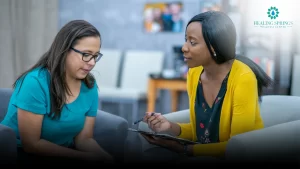Do you sometimes feel like your past is holding you hostage? Like certain memories, feelings, or reactions seem to come from somewhere deep and unresolved? For many people, the effects of childhood trauma can linger well into adulthood, influencing relationships, self-worth, and overall well-being.
The good news is that healing childhood trauma is possible, and with the right approach, you can reclaim the life you deserve.
What is Considered a Childhood Trauma?
Childhood trauma encompasses distressing experiences that overwhelm a child’s ability to cope. These experiences can take many forms:
- Physical, emotional, or sexual abuse
- Neglect or abandonment
- Witnessing domestic violence
- Losing a parent or caregiver
- Serious accidents or natural disasters
- Severe bullying
- Growing up with a family member with mental illness or substance abuse issues
While some traumatic events are obvious, others might seem subtle yet leave lasting impressions. Healing from childhood trauma begins with acknowledging these experiences and understanding their impact on your life.
How Childhood Trauma Affects Adult Life
When left unaddressed, childhood trauma can manifest in various ways:
Emotional Impact
- Persistent anxiety or depression
- Difficulty trusting others
- Low self-esteem and negative self-talk
- Unexplained feelings of shame or guilt
Behavioral Impact
- Self-destructive behaviors
- Difficulty maintaining healthy relationships
- Perfectionism or people-pleasing tendencies
- Substance abuse or addiction issues
Physical Impact
- Chronic health conditions
- Sleep disturbances
- Heightened stress response
- Unexplained physical symptoms
Signs of Repressed Childhood Trauma in Adults
Not everyone remembers their traumatic experiences clearly. Sometimes, childhood trauma reveals itself through various signs:
- Unexplainable triggers or emotional reactions
- Recurring nightmares or flashbacks
- Difficulty setting boundaries
- Chronic feelings of emptiness or disconnection
- Trust issues in relationships
- Persistent negative beliefs about yourself
- Physical symptoms with no medical explanation
Recognizing these signs is an important step in the journey of healing childhood trauma and beginning the recovery process.
The Path to Healing Childhood Trauma
Recovering from childhood trauma is not about forgetting the past but about processing childhood trauma in a way that reduces its power over your present life. Here’s how to begin:
1. Acknowledge and Validate Your Experiences
The journey to heal childhood trauma often begins with acknowledgment. Many trauma survivors minimize their experiences or question whether what happened “counts” as trauma.
- Give yourself permission to recognize your experiences as valid
- Understand that trauma is defined by its impact, not by comparison to others
- Release self-judgment about how the trauma has affected you
Remember that acknowledging trauma doesn’t mean dwelling in victimhood—it’s the first step toward empowerment and healing.
2. Seek Professional Support
While self-help strategies are valuable, professional guidance can be crucial for healing childhood trauma effectively:
- Therapy approaches like EMDR (Eye Movement Desensitization and Reprocessing), CBT (Cognitive Behavioral Therapy), or trauma-focused therapy can provide structured support
- Support groups connect you with others who understand your experiences
- Psychiatric care may help manage trauma-related symptoms like anxiety or depression
A trained professional can create a safe environment for processing childhood trauma and teach you effective coping strategies tailored to your needs.
3. Develop a Trauma-Informed Self-Care Practice
Self-care is essential for those recovering from childhood trauma:
- Practice grounding techniques to manage flashbacks or overwhelming emotions
- Establish routines that provide a sense of safety and predictability
- Engage in regular physical activity to release tension and trauma stored in the body
- Prioritize adequate sleep and nutrition to support your nervous system
Consistent self-care builds resilience and creates a foundation for deeper healing work.
4. Reconnect With Your Body
Trauma often disconnects us from our physical selves. To heal childhood trauma fully:
- Try body-centered practices like yoga, tai chi, or dance
- Practice mindfulness to increase body awareness
- Use breathing techniques to regulate your nervous system
- Consider somatic experiencing approaches that focus on physical sensations
Healing childhood trauma often includes reconnecting with the wounded parts of yourself—especially your inner child. If you notice recurring emotional triggers or deep-rooted self-worth issues, these may be signs your inner child needs healing.
5. Rewrite Your Narrative
The stories we tell ourselves about our trauma shape our healing journey:
- Identify negative beliefs formed during traumatic experiences
- Challenge these beliefs with compassionate self-talk
- Create a new narrative that acknowledges both pain and strength
- Focus on post-traumatic growth and the wisdom gained from your experiences
As you heal childhood trauma, you can transform from a victim to a survivor and, ultimately, to a thriver.
6. Set Healthy Boundaries
Many childhood trauma survivors struggle with boundaries. Learning to set and maintain healthy limits is crucial for healing:
- Practice identifying your needs and communicating them clearly
- Start with small boundaries and gradually build your confidence
- Recognize that healthy boundaries protect relationships rather than harm them
- Surround yourself with people who respect your boundaries
Setting boundaries is an act of self-respect that supports your ongoing healing process.
7. Find Meaning and Purpose
Many who successfully heal from childhood trauma discover that finding meaning in their experiences helps with recovery:
- Connect with communities that share your values
- Consider ways to help others with similar experiences
- Pursue activities that bring you joy and fulfillment
- Develop a spiritual practice if that resonates with you
Finding purpose doesn’t mean your trauma was “worth it,” but rather that you can create a meaningful life despite what happened.
Common Challenges in Healing Childhood Trauma
The path to healing isn’t always linear. You might encounter:
Resistance and Avoidance
Many trauma survivors unconsciously resist healing because facing painful memories feels threatening. Be patient with yourself if you notice avoidance patterns.
Relationship Difficulties
As you heal, you may notice changes in your relationships. Some connections may strengthen while others may no longer fit your healing journey.
Healing Fatigue
Processing childhood trauma takes energy. There may be times when you need to step back and focus on rest before continuing deeper healing work.
Triggers and Setbacks
Healing isn’t a straight line. Triggers may arise, and you might experience setbacks. These aren’t failures but normal parts of the recovery process.
When to Seek Additional Help
While recovering from childhood trauma is possible, certain situations warrant immediate professional support:
- Suicidal thoughts or self-harm urges
- Substance abuse that interferes with daily functioning
- Intense flashbacks that disrupt your ability to function
- Severe dissociation or loss of time
- Violence or abuse in current relationships
Remember that seeking help is a sign of strength, not weakness.
Reclaiming Your Life After Trauma
Healing childhood trauma isn’t about erasing the past—it’s about reducing its control over your present and future. With patience, support, and commitment to your well-being, you can process childhood trauma and build a life defined by your choices rather than your past experiences.
Remember that healing happens in layers. Some days you’ll feel strong progress, while others might feel like steps backward. Both are normal parts of the journey to recover from childhood trauma.
At Healing Springs Wellness, we specialize in trauma-informed care that helps you navigate this healing journey with compassion and expertise. Our therapists understand the complexities of childhood trauma and can provide personalized support for your unique situation.
Ready to begin your journey toward healing childhood trauma and reclaiming your life? Book a Consultation with one of our trauma-informed therapists who can help you develop a personalized recovery plan.
The path to healing may not always be easy, but you don’t have to walk it alone. With the right support, you can transform your relationship with your past and create a future filled with possibility and peace.
Frequently Asked Questions
How do you heal childhood trauma?
Healing childhood trauma involves a combination of professional support, self-care practices, body-centered approaches, narrative work, and community connection. The process takes time and patience but can lead to profound transformation and freedom from the past’s grip.
What are signs of repressed childhood trauma in adults?
Signs include unexplained anxiety or depression, difficulty in relationships, recurring nightmares, strong emotional reactions to seemingly minor triggers, chronic physical symptoms without medical explanation, and persistent negative beliefs about oneself or the world.
Are all mental disorders from past childhood trauma?
Not all mental health conditions stem from childhood trauma. Mental health is complex and can be influenced by biological factors, genetics, current life stressors, and various experiences throughout life. However, childhood trauma is a significant risk factor for many mental health challenges.
What is considered a childhood trauma?
Childhood trauma includes experiences that overwhelm a child’s ability to cope and create a sense of fear, helplessness, or horror. This may include abuse, neglect, loss of a caregiver, witnessing violence, natural disasters, serious accidents, or living with a family member who struggles with addiction or mental illness.
This article was reviewed by mental health professionals and is based on current psychological research and clinical experience. For specific medical advice, please consult with our qualified healthcare provider.




